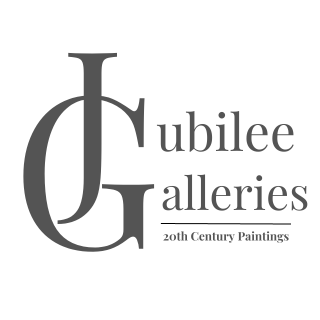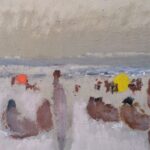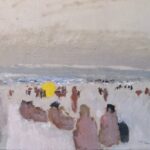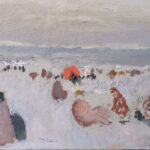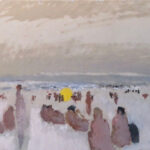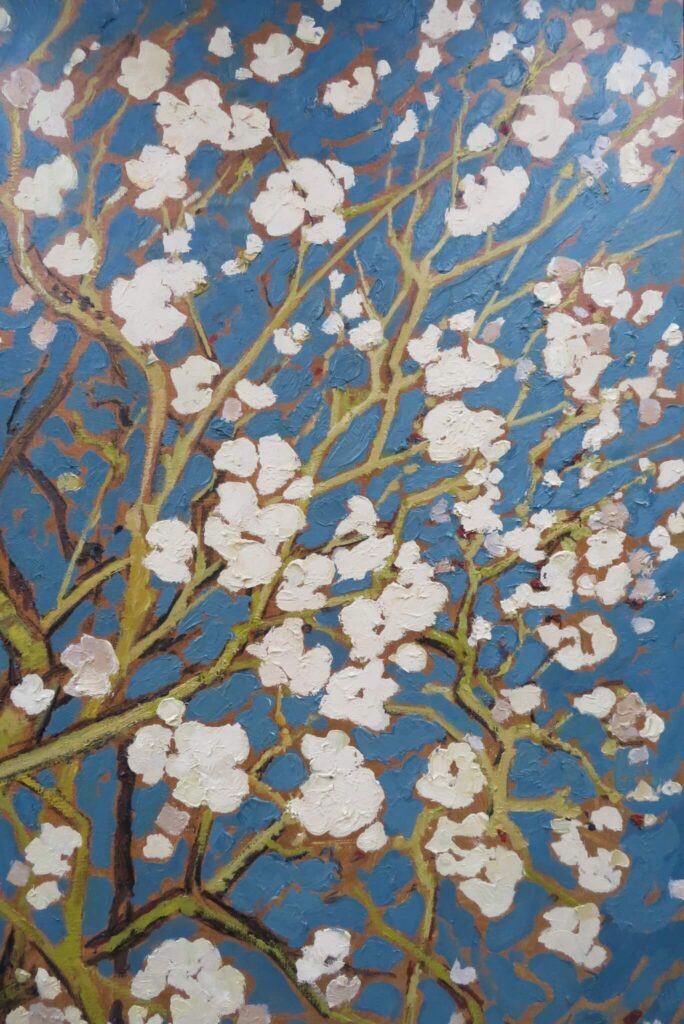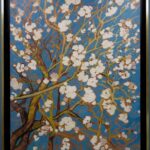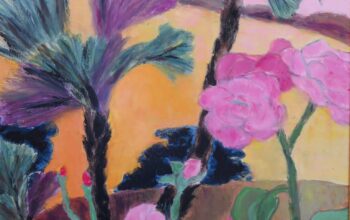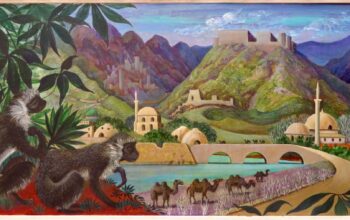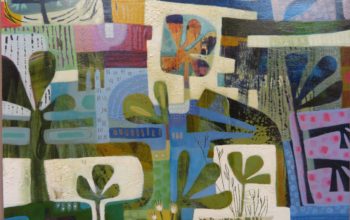Henri Andre Martin
ARTIST: Henri-Andre Martin (1914-2009) French
TITLE: “Beach Scene, Provence, Southern France”
SIGNED: unsigned – artists studio
MEDIUM: oil on canvas
SIZE: 100cm x 35cm unframed
CONDITION: excellent
PRICE: £sold
DETAIL: Born in Lyon in 1918 Henri-André Martin spent his youth in Saint-Étienne, his father, Edme Martin, first installed as a practicing doctor in Lyon, having been appointed doctor of the anti-tuberculosis dispensaries of the Loire. During his first years of studying medicine in Lyon, he nevertheless enrolled in the Beaux-Arts. Appointed hospital intern upon his return from captivity in 1942, he ended his medical career as director of the otolaryngology university clinic at Édouard-Herriot hospital. But painting was his passion. Painting was for Henri-André Martin the way of expressing his feelings. By nature very reserved and of an extreme modesty that many took for coldness, it was what allowed him to express his strong artistic sensitivity and, his pictorial periods are as many reflects of his anxieties, of his hopes, of his joys. At every period of his life, wherever he goes and whenever he has a moment, he paints gouaches, often of small size, but sometimes of larger size. He also paints beaches that have been compared to those of Boudin. Their invoice shows, however, that this figure is only appearance and that in fact, these beaches made of water, sky and sand, readily dispense with the motif, the work of the material seeming to have more importance. as the subject. Despite the fact that until the 1970s he painted “on the ground”, his canvases remain far removed from the anecdote. Often harsh like the landscapes of Provence, the Parisian walls which express concern, or the railways, the switch tracks which suggest, in ocher and black, all the embarrassment of choice. We find the same nostalgic gravity in the canvases of the carcasses of boats which, as his friend Louis Pons later wrote, “seem to die of immobility” or in the canvases of Venice, or the landscapes of Eygalières. In the following years, his painting became simpler, more synthetic, such as these landscapes with tortured almond trees, black and gnarled olive trees, plane trees standing out against the ocher sky of the dawn of Provence, in winter. These are also the canvases of Hamburg in the dough becomes heavier, the colors darken, marking all the gravity of the port landscapes. Workshop work gradually takes precedence over motif painting. The pivotal period coincides with that of his work on the olive tree, during which he leads the realization of the “Trunks”, a collection of six lithographic plates, of the book L’olivier comprising many lithographs and serigraphs, but also texts. poetic and numerous paintings. He then became passionate about everything related to the olive tree (literature, painting, traditions, history), but also to the tree itself, its thousand-year-old history, its poetry, its symbols, but also its culture, its size. oil production and mills, a passion that he will keep for the rest of his life. This work on the olive tree allowed him to achieve wide simplifications. Hence paintings with a symbolist character, in which one has the impression that the goal is not to represent this or that tree, but to summarize in an emblem, trunk, leaf and sky, the civilization of the olive tree. René Déroudille wrote about them in 1976: “There is a lyrical sap there which carries the artist along and pushes him to define the trees of dear Provence in a different way.” The ancestor “and especially the plates devoted to embrace and renewal, in poetry de fi nes the action of an artist who is also in full mutation “. The following years were marked by intense pictorial activity and the realization in the studio and from sketches on patterns, large canvases very often colored which were the subject of a major exhibition in 1988 at the Maison de Lyon. Bernard Gouttenoire wrote in Hebdo Lyon in June 1979 on this subject: “The fields of colza or lavender abundantly filling the canvas frame. . ..There could be “monotony” by practicing large flat areas, but precisely this is not the case and we never get tired of so many sublimated colors “. In the 1980s, Provence and especially the Alpilles, which had long been privileged themes, presented him with an intense source of inspiration and an evolution towards much more abstract canvases. These same years are marked by the realization of large nudes which with the Alpilles and other colored canvases are the subject of a major exhibition at L’Atrium in Lyon in 1992. During this period of the 1990s, he worked in the studio intensely, embarks on series, often abstract and undoubtedly necessary for its expression. René Déroudille wrote in 1992: “. . . he wants to go to the end of his work, that is to say to bring to their conclusion the shapes and colors born of his creative imagination. . . Slowly but surely, he arrived at a sort of plenitude, at the satisfaction of the task finally accomplished … Absolutely apart from the Lyon school, he seems unpretentious, reveling in an active solitude, where he feels close to his desires ”. Gradually, however, he dealt with more attractive, almost decorative subjects, such as Japanese flowers and butterflies. It takes up old themes with a frankly figurative style: bouquets of flowers, still lifes, landscapes of Eygalières.
Prizes and distinctions 1964: Maurice Utrillo Prize Out of competition, then medal of honor from the Société lyonnaise des Beaux-Arts Member of the Salon du Sud-Est until his death in 2004. Drawing and water painting fair, Paris
Member of the Salon of the National Society of Fine Arts, Paris Member of the Salon d’Automne, Paris Correspondent of the Institut de France His paintings were exhibited in great galleries in Paris, New-York, Dallas, Caracas & Genève
More Henri-Andre Martin paintings wanted. If you have pictures to sell then please contact the gallery.
ARTIST: Henry Andre Martin (1914-2004) French
TITLE: “Springtime”
SIGNED: lower left
MEDIUM: oil on canvas
SIZE: 100cm x 73cm framed
CONDITION: excellent
PRICE: £sold
DETAIL: A superb impressionist oil painting of a tree in blossom in springtime by Henry Martin. Born in Lyon in 1918 Henri-André Martin spent his youth in Saint-Étienne, his father, Edme Martin, first installed as a practicing doctor in Lyon, having been appointed doctor of the anti-tuberculosis dispensaries of the Loire. During his first years of studying medicine in Lyon, he nevertheless enrolled in the Beaux-Arts. Appointed hospital intern upon his return from captivity in 1942, he ended his medical career as director of the otolaryngology university clinic at Édouard-Herriot hospital. But painting was his passion. Painting was for Henri-André Martin the way of expressing his feelings. By nature very reserved and of an extreme modesty that many took for coldness, it was what allowed him to express his strong artistic sensitivity and, his pictorial periods are as many reflects of his anxieties, of his hopes, of his joys. At every period of his life, wherever he goes and whenever he has a moment, he paints gouaches, often of small size, but sometimes of larger size. He also paints beaches that have been compared to those of Boudin. Their invoice shows, however, that this figure is only appearance and that in fact, these beaches made of water, sky and sand, readily dispense with the motif, the work of the material seeming to have more importance. as the subject. Despite the fact that until the 1970s he painted “on the ground”, his canvases remain far removed from the anecdote. Often harsh like the landscapes of Provence, the Parisian walls which express concern, or the railways, the switch tracks which suggest, in ocher and black, all the embarrassment of choice. We find the same nostalgic gravity in the canvases of the carcasses of boats which, as his friend Louis Pons later wrote, “seem to die of immobility” or in the canvases of Venice, or the landscapes of Eygalières. In the following years, his painting became simpler, more synthetic, such as these landscapes with tortured almond trees, black and gnarled olive trees, plane trees standing out against the ocher sky of the dawn of Provence, in winter. These are also the canvases of Hamburg in the dough becomes heavier, the colors darken, marking all the gravity of the port landscapes. Workshop work gradually takes precedence over motif painting. The pivotal period coincides with that of his work on the olive tree, during which he leads the realization of the “Trunks”, a collection of six lithographic plates, of the book L’olivier comprising many lithographs and serigraphs, but also texts. poetic and numerous paintings. He then became passionate about everything related to the olive tree (literature, painting, traditions, history), but also to the tree itself, its thousand-year-old history, its poetry, its symbols, but also its culture, its size. oil production and mills, a passion that he will keep for the rest of his life. This work on the olive tree allowed him to achieve wide simplifications. Hence paintings with a symbolist character, in which one has the impression that the goal is not to represent this or that tree, but to summarize in an emblem, trunk, leaf and sky, the civilization of the olive tree. René Déroudille wrote about them in 1976: “There is a lyrical sap there which carries the artist along and pushes him to define the trees of dear Provence in a different way.” The ancestor “and especially the plates devoted to embrace and renewal, in poetry de fi nes the action of an artist who is also in full mutation “. The following years were marked by intense pictorial activity and the realization in the studio and from sketches on patterns, large canvases very often colored which were the subject of a major exhibition in 1988 at the Maison de Lyon. Bernard Gouttenoire wrote in Hebdo Lyon in June 1979 on this subject: “The fields of colza or lavender abundantly filling the canvas frame. . ..There could be “monotony” by practicing large flat areas, but precisely this is not the case and we never get tired of so many sublimated colors “. In the 1980s, Provence and especially the Alpilles, which had long been privileged themes, presented him with an intense source of inspiration and an evolution towards much more abstract canvases. These same years are marked by the realization of large nudes which with the Alpilles and other colored canvases are the subject of a major exhibition at L’Atrium in Lyon in 1992. During this period of the 1990s, he worked in the studio intensely, embarks on series, often abstract and undoubtedly necessary for its expression. René Déroudille wrote in 1992: “. . . he wants to go to the end of his work, that is to say to bring to their conclusion the shapes and colors born of his creative imagination. . . Slowly but surely, he arrived at a sort of plenitude, at the satisfaction of the task finally accomplished … Absolutely apart from the Lyon school, he seems unpretentious, reveling in an active solitude, where he feels close to his desires ”. Gradually, however, he dealt with more attractive, almost decorative subjects, such as Japanese flowers and butterflies. It takes up old themes with a frankly figurative style: bouquets of flowers, still lifes, landscapes of Eygalières.
Prizes and distinctions 1964: Maurice Utrillo Prize Out of competition, then medal of honor from the Société lyonnaise des Beaux-Arts Member of the Salon du Sud-Est until his death in 2004. Drawing and water painting fair, Paris
Member of the Salon of the National Society of Fine Arts, Paris Member of the Salon d’Automne, Paris Correspondent of the Institut de France His paintings were exhibited in great galleries in Paris, New-York, Dallas, Caracas & Genève
